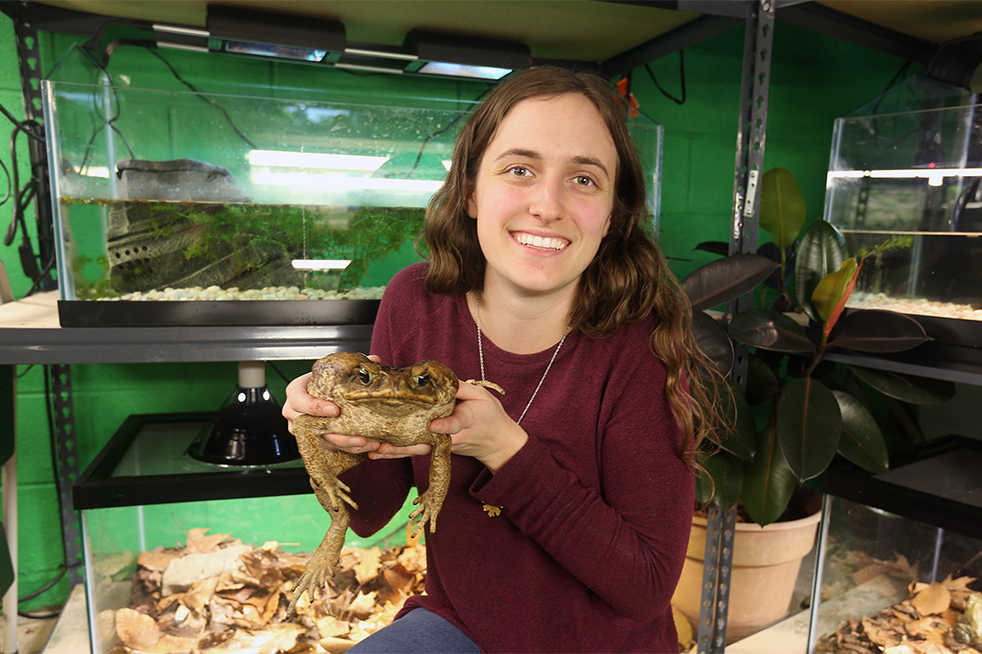It is often assumed that frog tongues are sticky, but not much research had gone into the actual science of the mechanics of the frog tongue. Alexis C. Noel, inspired by a YouTube video of a frog playing “Ant Smasher” on an iPad, decided to look into how exactly a frog’s tongue worked.
Cooperating with the Amphibian Foundation in Atlanta, Noel collected samples from 18 frogs and filmed high speed footage, which can be found in her new study “Frogs Use a Viscoelastic Tongue and Non-Newtonian Salvia to Catch Prey,” published recently in the Journal of the Royal
Society Interface.
Noel is a fourth-year Ph.D. student at Tech. She got her undergraduate degree at Tech in mechanical engineering. Her proficiency with frog tongues is seemingly random, but frog tongues are not the first run-in she has had with investigations into
animal tongues.
Noel’s earlier research included studying cat tongues to see “how animals grab with soft, malleable surfaces.” Inspired by seeing her cat lick a microfiber blanket, Noel investigated the structure of the its tongue. She has even 3D-printed a model cat tongue and has applied for a patent on the design.
“I didn’t know engineers could work with animals,” Noel said. “Cats and frogs are my two favorite animals, so this is a childhood dream come true.”
Noel’s research explains why a frog’s tongue is able to pull 1.4 times its body weight.
“We weren’t the first people to talk about sticky tongues, but we
definitely went the most in-depth, like us Georgia Tech people do,” Noel said.
The strength comes from the frog’s tongue and the frog’s saliva working together. Noel learned that frog saliva is a non-Newtonian fluid, which means that it exhibits different properties when it is travelling at different speeds; for example, an upside-down ketchup bottle will result in a trickle out of the bottle, but if one squeezes it, the ketchup flows
right out.
Frog saliva exhibits the same properties. When the tongue accelerates out of the mouth, the saliva is a watery fluid. This fluid property is advantageous because it allows the saliva to fill the crevices of the insect. When the tongue makes contact with the insect, it begins to slow down, and the saliva changes properties.
When travelling slowly, frog saliva is 50,000 times more viscous than human saliva. The insect sticks to the tongue as the tongue retracts into the mouth, and the saliva regains its fluid properties as the frog swallows the insect.
According to Noel, the mechanics of the frog’s tongue structure is critical to this process, since the saliva’s properties are dependent upon the speed at which it is moving.
When going bridge jumping, for example, a bungee cord stores energy as one approaches the ground so the jumper can slow down as they approach the ground before speeding back up in their re-ascent. The frog’s tongue acts as similarly to a bungee cord by slowing down as it reaches the prey. This allows the saliva to become more viscous, and within the blink of an eye, the frog catches its next meal.
Noel thinks her new research can be useful for commercial adhesives and space travel. She imagines a world in which frog tongues are attached to Amazon drones, so they can pick up packages and accomplish adhesion at high acceleration.
Furthermore, grabbing things in the vacuum of space is a difficult task, so it may be advantageous to grab things with just a layer of fluid. Although Noel’s lab is still full of tongues, she says she hopes to get her Ph.D. and move into a somewhat different sphere.
“I hope to take my passion of 3D printing and combine it with my knowledge of materials and biology … [and] go into the world of soft robotics, primarily with manufacturing processes,”
Noel said.
She admits that the tongues are gross, but she loves her research and is glad she is at a school with a culture that prides itself on understanding how something seemingly simple actually works. “That’s what our lab is famous for,” Noel said, “taking commonplace things and showing the science behind them.”
Noel’s research team worked closely with an acclaimed group in the field of frog research on this project; Mark Mandica, lead herpetologist at the Atlanta Amphibian Foundation, worked with the group during the course of the project. The Amphibian Foundation works primarily to understand the possible causes of global declines in amphibian populations, through the lenses of amphibian biology, applied sciences and conservation sciences. The foundation currently estimates that nearly 40 percent of the global amphibian population is in decline or already extinct.
“Frogs Use a Viscoelastic Tongue and Non-Newtonian Saliva to Catch Prey” was published Feb. 1 and is co-authored by Hao-Yuan Guo, Mark Mandica and David L. Hu. Hu is a faculty member at Tech, currently serving as a mechanical engineering professor and Noel’s faculty advisor.
